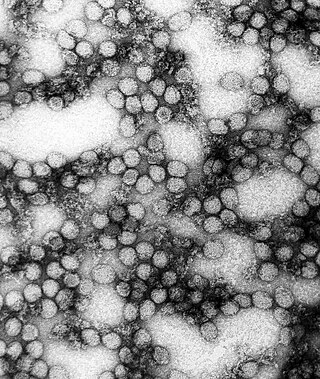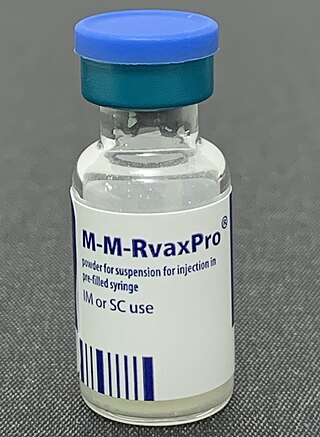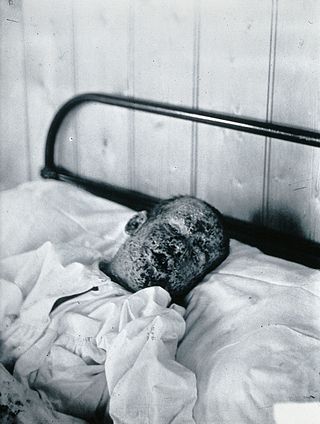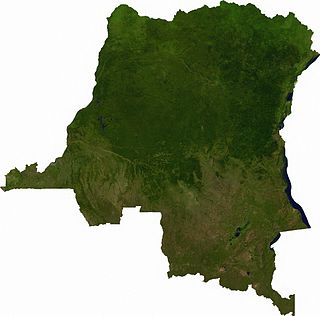Related Research Articles

Typhoid fever, also known as typhoid, is a disease caused by Salmonella serotype Typhi bacteria. Symptoms vary from mild to severe, and usually begin six to 30 days after exposure. Often there is a gradual onset of a high fever over several days. This is commonly accompanied by weakness, abdominal pain, constipation, headaches, and mild vomiting. Some people develop a skin rash with rose colored spots. In severe cases, people may experience confusion. Without treatment, symptoms may last weeks or months. Diarrhea may be severe, but is uncommon. Other people may carry it without being affected, but are still contagious. Typhoid fever is a type of enteric fever, along with paratyphoid fever. S. enterica Typhi is believed to infect and replicate only within humans.

Yellow fever is a viral disease of typically short duration. In most cases, symptoms include fever, chills, loss of appetite, nausea, muscle pains – particularly in the back – and headaches. Symptoms typically improve within five days. In about 15% of people, within a day of improving the fever comes back, abdominal pain occurs, and liver damage begins causing yellow skin. If this occurs, the risk of bleeding and kidney problems is increased.

Measles is a highly contagious, vaccine-preventable infectious disease caused by measles virus. Symptoms usually develop 10–12 days after exposure to an infected person and last 7–10 days. Initial symptoms typically include fever, often greater than 40 °C (104 °F), cough, runny nose, and inflamed eyes. Small white spots known as Koplik's spots may form inside the mouth two or three days after the start of symptoms. A red, flat rash which usually starts on the face and then spreads to the rest of the body typically begins three to five days after the start of symptoms. Common complications include diarrhea, middle ear infection (7%), and pneumonia (6%). These occur in part due to measles-induced immunosuppression. Less commonly seizures, blindness, or inflammation of the brain may occur. Other names include morbilli, rubeola, red measles, and English measles. Both rubella, also known as German measles, and roseola are different diseases caused by unrelated viruses.

The MMR vaccine is a vaccine against measles, mumps, and rubella, abbreviated as MMR. The first dose is generally given to children around 9 months to 15 months of age, with a second dose at 15 months to 6 years of age, with at least four weeks between the doses. After two doses, 97% of people are protected against measles, 88% against mumps, and at least 97% against rubella. The vaccine is also recommended for those who do not have evidence of immunity, those with well-controlled HIV/AIDS, and within 72 hours of exposure to measles among those who are incompletely immunized. It is given by injection.

Mpox is an infectious viral disease that can occur in humans and some other animals. Symptoms include a rash that forms blisters and then crusts over, fever, and swollen lymph nodes. The illness is usually mild and most of those infected will recover within a few weeks without treatment. The time from exposure to onset of symptoms ranges from five to twenty-one days and symptoms typically last from two to four weeks. Cases may be severe, especially in children, pregnant women or people with suppressed immune systems.

Crimean–Congo hemorrhagic fever (CCHF) is a viral disease. Symptoms of CCHF may include fever, muscle pains, headache, vomiting, diarrhea, and bleeding into the skin. Onset of symptoms is less than two weeks following exposure. Complications may include liver failure. Survivors generally recover around two weeks after onset.

Chikungunya is a mosquito-borne alpha virus that was first isolated after a 1952 outbreak in modern-day Tanzania. The virus has circulated in forested regions of sub-Saharan African in cycles involving nonhuman primate hosts and arboreal mosquito vectors. Phylogenetic studies indicate that the urban transmission cycle—the transmission of a pathogen between humans and mosquitoes that exist in urban environments—was established on multiple occasions from strains occurring on the eastern half of Africa in non-human primate hosts. This emergence and spread beyond Africa may have started as early as the 18th century. Currently, available data does not indicate whether the introduction of chikungunya into Asia occurred in the 19th century or more recently, but this epidemic Asian strain causes outbreaks in India and continues to circulate in Southeast Asia.

Polio eradication, the permanent global cessation of circulation of the poliovirus and hence elimination of the poliomyelitis (polio) it causes, is the aim of a multinational public health effort begun in 1988, led by the World Health Organization (WHO), the United Nations Children's Fund (UNICEF) and the Rotary Foundation. These organizations, along with the U.S. Centers for Disease Control and Prevention (CDC) and The Gates Foundation, have spearheaded the campaign through the Global Polio Eradication Initiative (GPEI). Successful eradication of infectious diseases has been achieved twice before, with smallpox in humans and rinderpest in ruminants.

The African Union-United Nations Hybrid Operation in Darfur was a joint African Union (AU) and United Nations (UN) peacekeeping mission formally approved by United Nations Security Council Resolution 1769 on 31 July 2007, to bring stability to the war-torn Darfur region of Sudan while peace talks on a final settlement continue.

The eradication of infectious diseases is the reduction of the prevalence of an infectious disease in the global host population to zero.
Sudan is still one of the largest countries in Africa even after the split of the Northern and Southern parts. It is one of the most densely populated countries in the region and is home to over 37.9 million people.

Measles vaccine protects against becoming infected with measles. Nearly all of those who do not develop immunity after a single dose develop it after a second dose. When rate of vaccination within a population is greater than 92%, outbreaks of measles typically no longer occur; however, they may occur again if the rate of vaccination decrease. The vaccine's effectiveness lasts many years. It is unclear if it becomes less effective over time. The vaccine may also protect against measles if given within a couple of days after exposure to measles.

Yellow fever vaccine is a vaccine that protects against yellow fever. Yellow fever is a viral infection that occurs in Africa and South America. Most people begin to develop immunity within ten days of vaccination and 99% are protected within one month, and this appears to be lifelong. The vaccine can be used to control outbreaks of disease. It is given either by injection into a muscle or just under the skin.

On 20 January 2016, the health minister of Angola reported 23 cases of yellow fever with 7 deaths among Eritrean and Congolese citizens living in Angola in Viana municipality, a suburb of the capital of Luanda. The first cases were reported in Eritrean visitors beginning on 5 December 2015 and confirmed by the Pasteur WHO reference laboratory in Dakar, Senegal in January. The outbreak was classified as an urban cycle of yellow fever transmission, which can spread rapidly. A preliminary finding that the strain of the yellow fever virus was closely related to a strain identified in a 1971 outbreak in Angola was confirmed in August 2016. Moderators from ProMED-mail stressed the importance of initiating a vaccination campaign immediately to prevent further spread. The CDC classified the outbreak as Watch Level 2 on 7 April 2016. The WHO declared it a grade 2 event on its emergency response framework having moderate public health consequences.

The Democratic Republic of the Congo (DRC) was identified by the World Health Organization (WHO) on 11 May 2017 as having one Ebola-related death.

The 2018 Équateur province Ebola outbreak occurred in the north-west of the Democratic Republic of the Congo (DRC) from May to July 2018. It was contained entirely within Équateur province, and was the first time that vaccination with the rVSV-ZEBOV Ebola vaccine had been attempted in the early stages of an Ebola outbreak, with a total of 3,481 people vaccinated. It was the ninth recorded Ebola outbreak in the DRC.
Daniel R. Lucey is an American physician, researcher, senior scholar and adjunct professor of infectious diseases at Georgetown University, and a research associate in anthropology at the Smithsonian National Museum of Natural History, where he has co-organised an exhibition on eight viral outbreaks.

The COVID-19 pandemic in Sudan was a part of the worldwide pandemic of coronavirus disease 2019 caused by severe acute respiratory syndrome coronavirus 2. The virus was confirmed to have reached Sudan in March 2020.
References
- ↑ Yuill, Thomas M; Woodall, John P; Baekeland, Susan (2013). "Latest outbreak news from ProMED-mail. Yellow fever outbreak-Darfur Sudan and Chad". Int J Infect Dis. 17 (7): e476–e478. doi: 10.1016/j.ijid.2013.03.009 .
- ↑ "Targeting yellow fever in Sudan". World Health Organization. Archived from the original on December 12, 2012. Retrieved 28 June 2015.
- ↑ "PRO/EDR> Yellow fever - Africa (12): Sudan (Darfur) 2013-03-02 15:02:44 Archive Number: 20130302.1567578".
- ↑ "PRO/AH/EDR> Yellow fever - Africa (15): Sudan (Darfur) WHO 2012-11-13 18:01:32 Archive Number: 20121113.1407906" . Retrieved 28 June 2015.
- ↑ "Yellow Fever Outbreak in Sudan". HealthMap. The Disease Daily. 31 Oct 2012. Archived from the original on 1 July 2015. Retrieved 28 June 2015.
- ↑ "Sudan Begins Emergency Vaccinations to Fight Yellow Fever Outbreak". Voice of America. 7 December 2012. Retrieved 28 June 2015.
- ↑ "PRO/AH/EDR> Yellow fever - Africa (22): Sudan (Darfur) 2012-11-23 08:15:02 Archive Number: 20121123.1420747".
- ↑ "Yellow fever outbreak kills 164 in Sudan's Darfur: WHO". Reuters. Dec 3, 2012. Retrieved 28 June 2015.
- ↑ "Yellow Fever: China Plans to Scan Travelers From Sudan". New York Times. 7 January 2013. Retrieved 28 June 2015.
- ↑ Monath, TP; Vasconcelos, PF (March 2015). "Yellow fever". Journal of Clinical Virology. 64: 160–73. doi:10.1016/j.jcv.2014.08.030. PMID 25453327. S2CID 5124080.
- ↑ "Yellow fever in Sudan". World Health Organization. Archived from the original on August 10, 2014. Retrieved 28 June 2015.
- ↑ "Sudan: Unamid Lends Resources to Fighting Yellow Fever in Darfur". AllAfrica. 2 December 2012. Retrieved 28 June 2015.
- ↑ "Sudan Combats Darfur Outbreak". New York Times. 20 November 2012. Retrieved 28 June 2015.
- ↑ "PRO/AH/EDR> Yellow fever - Africa (06): Sudan (Darfur) 2013-01-25 10:43:16 Archive Number: 20130125.1513849". Pro-MED-mail. International Society for Infectious Diseases.
- ↑ "PRO/AH/EDR> Yellow fever - Africa (35): Sudan (Darfur) 2012-12-08 20:46:04 Archive Number: 20121208.1443535". International Society for Infectious Diseases.
- ↑ "PRO/AH/EDR> Yellow fever - Africa (04): Sudan (Darfur) 2013-01-11 16:16:14 Archive Number: 20130111.1493162". International Society for Infectious Diseases.
- ↑ "PRO/AH> Yellow fever - Africa (03): Sudan (Darfur) 2013-01-07 19:33:51 Archive Number: 20130107.1486073". Pro-MED-mail. International Society for Infectious Diseases.